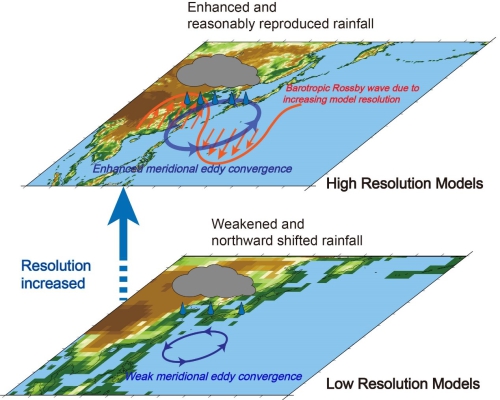Scientists Explain Why High-resolution Climate Model Simulates the East Asian Summer Monsoon Rain Belt Better
Date:2018-01-18
East Asian Summer Monsoon (EASM) has striking impacts on the local climate and water resource of eastern China where both population and economy are dense. General circulation models (GCM) are powerful tools to study monsoons but uncertainties exist in simulating climatological features of the EASM rain belt. Previous studies demonstrated that high-resolution models could more efficiently reproduce the EASM rainfall than low-resolution models. However, the mechanisms of increasing resolution responsible for the improvements remain unknown.
Recently, Dr. YAO Junchen, Prof. ZHOU Tianjun and their colleagues from the Institute of Atmospheric Physics (IAP) of the Chinese Academy of Sciences revealed the mechanisms by using a new analysis method named moist static energy (MSE) balance analysis, a method introduced by Chou and Neelin.
Categorizing 16 Coupled Model Intercomparison Project Phase 5(CMIP5) models into low- and high-resolution groups, the research team found the high-resolution models had superiorities in simulating the EASM rain belt, in particular, with significant improvements in rainfall intensity and spatial pattern. Their MSE balance analysis showed the improvements from high-resolution models could be attributed to the intensified stationary meridional convergence along the EASM rain belt. The wave activity flux analysis further proved a stronger barotropic Rossby wave generated downstream of the Tibetan Plateau in the high-resolution group, resulting in the enhanced stationary meridional convergence.
Moreover, they applied a series of sensitivity experiments using the CAM5 model with the precisely same dynamic core and physics schemes at three different resolutions (~2°, 1°, and 0.5°), which thoroughly supported their main conclusions in isolation from the various model physics schemes in CMIP5 results.

Schematic of the high-resolution climate model improves the simulation of the EASM rain belt. Due to increasing model resolution, a barotropic Rossby wave response downstream of the Tibetan Plateau is generated. It further intensifies meridional convergence and moisture convergence along the EASM rain belt. Thus, the EASM rain belt is improved in the high-resolution models. (Image by YAO Junchen)
"Compared with the traditional analysis method derived from the dry thermodynamic equation that lacks the quantification of diabatic heat terms’ contributions, the MSE balance analysis offers us a better insight into the model heat processes including radiation, latent and sensible heats. This leads us to get a vivid image of the importance of the stationary meridional convergence,” says YAO, lead author of the study published in Journal of Climate .
"However, the resolution of high-resolution models in our study is around 50~20 km, and the resolution of the newest convection resolve models (CRM) is beyond 5km. How to improve the simulation of the EASM rainfall by using CRM is our next target," says GUO, one of the co-authors of the study.
Citation:
Yao Junchen, Tianjun Zhou, Zhun Guo, Xiaolong Chen, Liwei Zou, Yong Sun, 2017: Improved performance of High-Resolution Atmospheric Models in simulating the East-Asian Summer Monsoon Rainbelt. Journal of Climate 30(21), 8825-8840, https://doi.org/10.1175/JCLI-D-16-0372.1
Media contact: Ms. LIN Zheng, jennylin@mail.iap.ac.cn
